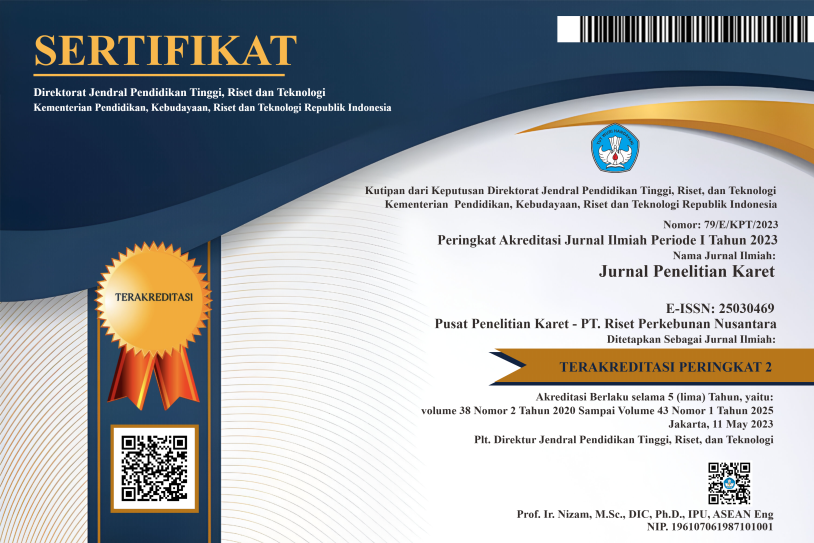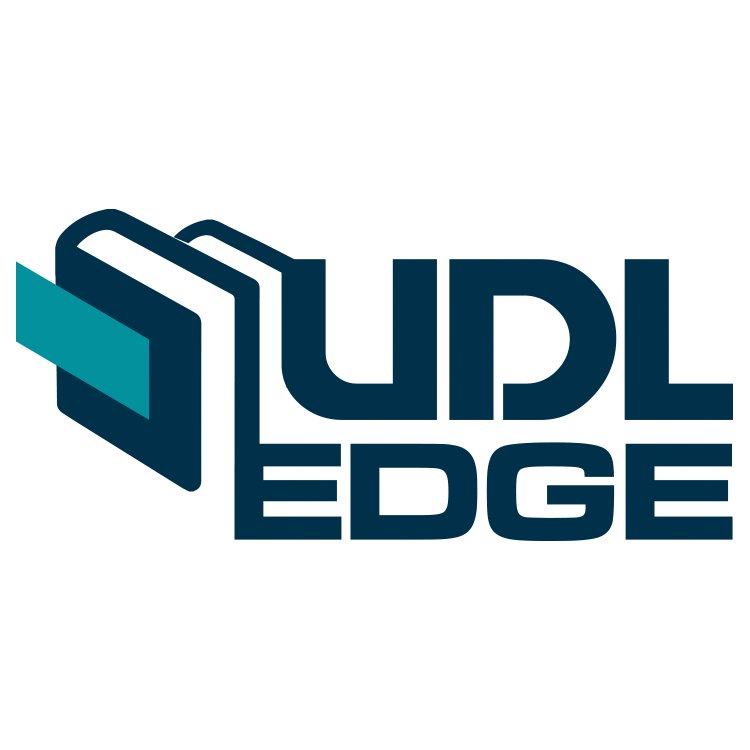KARET ALAM HIDROGENASI SEBAGAI MATRIKS POLIMER ALTERNATIF PADA KOMPOSIT ELASTOMER BANTALAN JEMBATAN
DOI:
https://doi.org/10.22302/ppk.jpk.v41i2.872Keywords:
hidrogenasi, karet alam, karet bantalan jembatan, matriks polimerAbstract
Karet alam hidrogenasi yang terbuat melalui modifikasi kimiawi lateks karet alam secara transfer hidrogenasi katalitik berpotensi digunakan sebagai matriks polimer alternatif pada karet bantalan jembatan. Penelitian ini dilakukan untuk mengkaji peluang pemanfaatan karet alam hidrogenasi pada pembuatan karet bantalan jembatan. Karet alam hidrogenasi yang digunakan pada penelitian ini disintesis pada variasi konsentrasi hidrasin hidrat (40 dan 42,5 bsk) terhadap hidrogen peroksida (30 dan 35 bsk) suhu 40oC dan 50oC. Eksperimen diawali dengan persiapan kompon karet menggunakan mesin giling terbuka dilanjutkan dengan pembuatan vulkanisat karet pada mesin cetak hidraulik. Vulkanisat karet dikarakterisasi sifat fisik dan mekanik mengikuti parameter yang tercantum dalam SNI 3967:2013. Karet SIR 20 digunakan sebagai pembanding. Hasil pengujian menunjukkan bahwa karet alam hidrogenasi yang diolah dari 40 bsk hidrasin hidrat dan 35 bsk hidrogen peroksida pada suhu 40oC ditetapkan sebagai matriks polimer alternatif yang paling menjanjikan untuk produk karet bantalan jembatan. Vulkanisat karet bantalan jembatan dari karet alam hidrogenasi tersebut memiliki sifat fisik dan mekanik yang sesuai dengan persyaratan SNI 3967:2013 dan persentasi rentensi yang lebih tinggi daripada vulkanisat karet bantalan jembatan dari SIR 20.
References
Arayapranee, W., & Rempel, G. L. (2009). Synthesis and mechanical properties of diimide hydrogenated natural rubber vulcanizates. Journal of Applied Polymer Science, 114(6) 4066-4075. doi: 10.1002/app.31132.
Choun, Y. S., Park, J., & Choi, I. K. (2014). Effect of mechanical property variability in lead rubber bearings on the response of seismic isolation system for different ground motions. Nuclear Engineering and Technology, 46(5): 605-618.doi: 10.5516/NET.09.2014.718.
Dolati, S. S. K., Mehrabi, A., & Dolati, S. S. K. (2021). Application of viscous damper and laminated rubber bearing pads for bridges in seismic regions. Metals, 11(11): 1666. doi: 10.3390/met11111666
Formela, K., Wasowiccz, D., Formela, M., Hejna, A., & Haponiuk, J. (2015). Curing characteristics, mechanical and thermal properties of reclaimed ground tire rubber cured with various vulcanizing systems. Iranian Polymer Journal, 24: 289-297. doi: 10.1007/s13726-015-0320-9
Gonzalez, L., Rodriguez, A., Valentin, J. L., Marcos-Fernandez, A., & Posadas, P. (2005). Conventional and efficient crosslinking of natural rubber. KGK Rubberpoint, 58: 638-646.
Gu, H. S., & Itoh, Y. (2012). Aging inside natural rubber bearings and prediction method. Journal of Beijing University of Technology, 38(2): 186-193.
Hamaguchi, H., Samejima, Y., & Kani, N. (2009). A study of aging effect on rubber bearings after about twenty years in used. Proceedings of 11th World Conference on Seismic Isolation, Energy Dissipation and Active Vibration Control of Structures, Guangzhou, China, November 17-21 2009.
Hinchiranan, N., Lertweerasirikun, W., Poonsawad, W., Rempel, G. L., & Prasassarakich, P. (2009). Hydrogenated natural rubber blends: aspect on thermal stability and oxidative behaviour. Journal of Applied Polymer Science, 113(3): 1556-1575. doi: 10.1002/app.30034
Ikeda, Y., Phinyocheep, P., Kittipoom, S., Ruancharoen, J., Kokubo, Y., Morita, Y., Hijikata, K., & Kohjiya, S. (2008). Mechanical characteristic of hydrogenated natural rubber vulcanizates. Polymer for Advanced Technologies, 19: 1608-1615. doi: 10.1002/pat.1176
Inoue, S., & Nishio, T. (2007). Synthesis and properties of hydrogenated natural rubber. Journal of Applied Polymer Science, 103(6): 3957-3963. doi: 10.1002/app.25158
Jovanovic, V., Budinski-Simendic, J., Koruguc-Karasz, L., Aroguz, A., Milic, J., Vukic, N., Markovic, G., & Dugic, P. (2019). Compression set and damping properties of oil-extended elastomer for sealant production. Natural Science, 9(1): 1-6. doi: 10.5937/UNIVTHO9-18802
Jun, X., Zhang, Y., & Shan, C. (2017). Compressive behaviour of laminated neoprene bridge bearing pads under thermal aging condition. AIP Conference Proceedings, 1890, 040018. doi: 10.1063/1.5005220
Kruzelak, J., Sykora, R., & Hudec, I. (2015). Influence of mixed sulfur/peroxide curing system and thermo-oxidative ageing on the properties of rubber magnetic composite. Journal of Polymer Research, 22: 636-645. doi: 10.1007/s10965-014-0636-8
Kruzelak, J., Kvasnicakova, A., & Hudec, I. (2020). Peroxide curing system applied for cross-linking of rubber compounds based on SBR. Advanced Industrial and Engineering Polymer Research, 3: 120-128. doi: 10.1016/j.aiepr.2020.05.001
Larpkasemsuk, A., Raksaksri, L., Chuayjuljit, S., Chaiwutthinan, P., & Boonmahitthisud, A. (2019). Effects of sulfur vulcanization system on cure characteristic, physical properties and thermal aging of epoxidized natural rubber. Journal of Metals, Materials, and Minerals, 29(1): 49-57.
Mahittikul, A., Prasassarakich, P., & Rempel, G. L. (2007). Noncatalytic hydrogenation of natural rubber latex. Journal of Applied Polymer Science, 103(5): 2885-2895. doi: 10.1002/app.25449
Mahittikul, A., Prasassarakich, P., & Rempel, G. L. (2009). Hydrogenation of natural rubber latex in the presence of [Ir)cod)(Pcy3)(py)]PF6. Journal of Molecular Catalysis A: Chemical, 297(2): 135-141. doi: 10.1016/j.molcata.2008.09.006
Ngamsurat, S., Boonkerd, K., Leela-adisorn, U., & Potiyaraj, P. (2011). Curing characteristic of natural rubber filled with gypsum. Energy Procedia, 9: 452-458.doi: 10.1016/j.egypro.2011.09.051
Noriman, N. Z., & Ismail, H. (2012). Effect of epoxidized natural rubber on thermal properties, fatique life, and natural weathering test of styrene butadiene rubber/recycled acrylonitrile-butadiene rubber (SBR/NBRr) blends. Journal of Applied Polymer Science, 123(2): 779-787. doi: 10.1002/app.34501
Othman, A. (2001). Property profile of a laminated rubber bearing. Polymer Testing, 20(2): 159-166. doi: 10.1016/S0142-9418(00)00017-9
Pimolsiriphol, V., Saeoui, P., & Sirisinha, C. (2007). Relationship among thermal ageing degradation, dynamic properties, cure system and antioxidants in natural rubber vulcanizates. Polymer – Plastic Technology and Engineering, 46: 113-121.doi: 10.1080/03602550601152861
Piya-areetham, P., Prasassarakich, P., & Rempel, G. L. (2013). Organic solvent-free hydrogenation of natural rubber latex and syntetic polyisoprene emulsion catalysed by water soluble rhodium complexes. Journal of Molecular Catalysis A: Chemical, 372: 151-159. doi: 10.1016/j.molcata.2013.02.025
Poschl, M., Sathi, S. G., & Stocek, R. (2022). Tuning the curing efficiency of conventional accelerated sulfur system for tailoring the properties of natural rubber/bromobutyl rubber blends. Materials, 15: 8466. doi: 10.3390/ma15238466
Puspitasari, S., & Cifriadi, A. (2017). Katalitik hidrogenasi lateks karet alam dengan senyawa diimida pada skala semi pilot. Majalah Kulit, Karet, dan Plastik, 33(2): 85-92. doi: 10.20543/mkkp.v33i2.3327
Rajan, R., Varghese, S., & George, K. E. (2012). Kinetics of peroxide vulcanization of natural rubber. Progress in Rubber, Plastic and Recycling Technology, 28(4): 201-220.doi: 10.1177/147776061202800405
Sanchez, M. A. G., Giraldo-Vasquez, D. H., & Sanchez, R. M. (2021). The effect of thermal aging on the mechanical properties of natural rubber based compounds used for rubber bearings. Journal of Engineering and Technological Science, 53(3): 210310.doi: 10.5614/j.eng.technol.sci.2021.53.3.10
Saputra, A. (2021). Review: Application of irradioation technology in natural rubber vulcanization process. Jurnal Forum Nuklir, 15(1): 1-11.
Thitithammawong, A., Utaipan, N., & Rungvichaniwat, A. (2012). The effect of the ratios of sulfur to peroxide mixes vulcanization system on the properties of dynamic vulcanized natural rubber and polypropylene blends. Songklanarin Journal of Science and Technology, 34(6): 653-662.
Yahya, Y. S. R., Azura, A. R., & Ahmad, Z. (2011). Effect of curing system on thermal degradation behaviour of natural rubber (SMR CV 60). Journal of Physical Science, 22(2): 1-14. doi: 10.13140/RG.2.1.1419.5683
Zhao, J., Ghebremeskel, G., & Peasely, J. (2001). Properties of EPDM/SBR blends cured with peroxide and sulfur coagent. Elastomer and Plastics, 5: 223-228.
Downloads
Published
How to Cite
Issue
Section
License
Copyright (c) 2023 Santi Puspitasari, Mochammad Chalid, Asron Ferdian Falaah, Adi Cifriadi

This work is licensed under a Creative Commons Attribution-ShareAlike 4.0 International License.
Submission of a original research article in Jurnal Penelitian Karet implies that the submitted  manuscript has not been published in any scientific journal (except being part of the abstract, thesis, or report). The submitted manuscript also is not under consideration for publication elsewhere. All co-authors involve in the publication of the manuscript should give their approval.
Once, the manuscript is accepted and then published in Jurnal penelitian Karet, the Author(s) keep hold the copyright and retain publishing right without restrictions.
Author(s) and Jurnal Penelitian Karet users are allowed to multiply the published manuscript. The journal users are also permissible to share the published manuscript with an acknowledgement to the Author(s). The Editorial Boards suggest that the Authors should manage patent before publishing their new inventions.
















